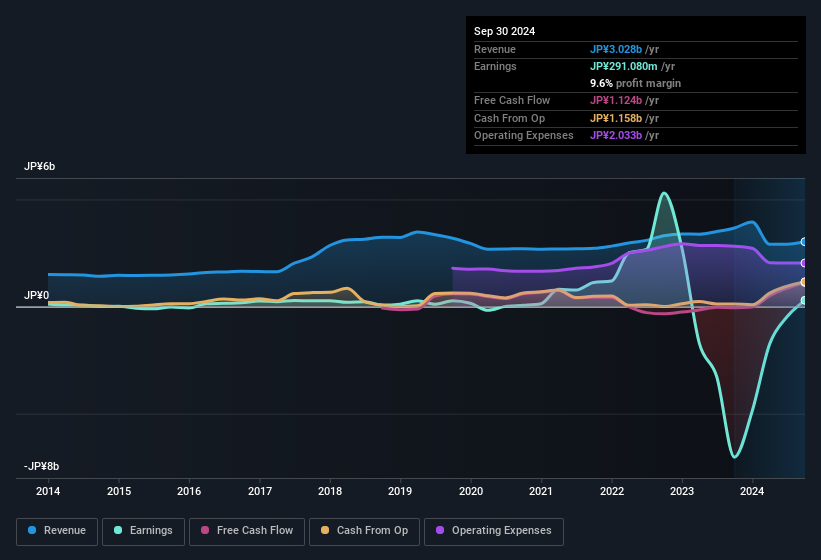Asteria Corporation's (TSE:3853) solid earnings announcement recently didn't do much to the stock price. We did some digging, and we think that investors are missing some encouraging factors in the underlying numbers.
See our latest analysis for Asteria

Examining Cashflow Against Asteria's Earnings
Many investors haven't heard of the accrual ratio from cashflow, but it is actually a useful measure of how well a company's profit is backed up by free cash flow (FCF) during a given period. To get the accrual ratio we first subtract FCF from profit for a period, and then divide that number by the average operating assets for the period. This ratio tells us how much of a company's profit is not backed by free cashflow.
Therefore, it's actually considered a good thing when a company has a negative accrual ratio, but a bad thing if its accrual ratio is positive. While having an accrual ratio above zero is of little concern, we do think it's worth noting when a company has a relatively high accrual ratio. To quote a 2014 paper by Lewellen and Resutek, "firms with higher accruals tend to be less profitable in the future".
Over the twelve months to September 2024, Asteria recorded an accrual ratio of -0.22. That indicates that its free cash flow quite significantly exceeded its statutory profit. In fact, it had free cash flow of JP¥1.1b in the last year, which was a lot more than its statutory profit of JP¥291.1m. Notably, Asteria had negative free cash flow last year, so the JP¥1.1b it produced this year was a welcome improvement. Having said that it seems that a recent tax benefit and some unusual items have impacted its profit (and this its accrual ratio).
Note: we always recommend investors check balance sheet strength. Click here to be taken to our balance sheet analysis of Asteria.
How Do Unusual Items Influence Profit?
Asteria's profit was reduced by unusual items worth JP¥4.0b in the last twelve months, and this helped it produce high cash conversion, as reflected by its unusual items. This is what you'd expect to see where a company has a non-cash charge reducing paper profits. It's never great to see unusual items costing the company profits, but on the upside, things might improve sooner rather than later. We looked at thousands of listed companies and found that unusual items are very often one-off in nature. And, after all, that's exactly what the accounting terminology implies. Asteria took a rather significant hit from unusual items in the year to September 2024. As a result, we can surmise that the unusual items made its statutory profit significantly weaker than it would otherwise be.
An Unusual Tax Situation
Moving on from the accrual ratio, we note that Asteria profited from a tax benefit which contributed JP¥358m to profit. It's always a bit noteworthy when a company is paid by the tax man, rather than paying the tax man. We're sure the company was pleased with its tax benefit. And given that it lost money last year, it seems possible that the benefit is evidence that it now expects to find value in its past tax losses. However, our data indicates that tax benefits can temporarily boost statutory profit in the year it is booked, but subsequently profit may fall back. In the likely event the tax benefit is not repeated, we'd expect to see its statutory profit levels drop, at least in the absence of strong growth. So while we think it's great to receive a tax benefit, it does tend to imply an increased risk that the statutory profit overstates the sustainable earnings power of the business.
Our Take On Asteria's Profit Performance
In conclusion, both Asteria's accrual ratio and its unusual items suggest that its statutory earnings are probably reasonably conservative, but the presence of a tax benefits may be inflating the numbers in a way that won't persist. Based on these factors, we think Asteria's earnings potential is at least as good as it seems, and maybe even better! So while earnings quality is important, it's equally important to consider the risks facing Asteria at this point in time. To help with this, we've discovered 3 warning signs (1 is concerning!) that you ought to be aware of before buying any shares in Asteria.
After our examination into the nature of Asteria's profit, we've come away optimistic for the company. But there are plenty of other ways to inform your opinion of a company. Some people consider a high return on equity to be a good sign of a quality business. While it might take a little research on your behalf, you may find this free collection of companies boasting high return on equity, or this list of stocks with significant insider holdings to be useful.
New: Manage All Your Stock Portfolios in One Place
We've created the ultimate portfolio companion for stock investors, and it's free.
• Connect an unlimited number of Portfolios and see your total in one currency
• Be alerted to new Warning Signs or Risks via email or mobile
• Track the Fair Value of your stocks
Have feedback on this article? Concerned about the content? Get in touch with us directly. Alternatively, email editorial-team (at) simplywallst.com.
This article by Simply Wall St is general in nature. We provide commentary based on historical data and analyst forecasts only using an unbiased methodology and our articles are not intended to be financial advice. It does not constitute a recommendation to buy or sell any stock, and does not take account of your objectives, or your financial situation. We aim to bring you long-term focused analysis driven by fundamental data. Note that our analysis may not factor in the latest price-sensitive company announcements or qualitative material. Simply Wall St has no position in any stocks mentioned.
About TSE:3853
Flawless balance sheet with questionable track record.
Market Insights
Community Narratives



